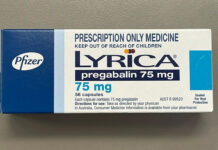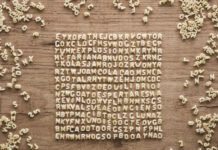From the 17th to the 20th centuries, Glauber’s salt was the laxative of choice.
Johann Rudolf Glauber (1604–70) was a very busy man. Not only did he relocate many times in Germany and Holland, he did so while producing and selling the latest chemicals and medicines. His output was so diverse and numerous that he’s been dubbed the world’s first ‘industrial chemist’.1,2
Glauber’s biggest seller was a laxative he named ‘sal mirabilis’, or miraculous salt. The story varies, but one version says that in 1625 Glauber got sick while visiting Naples. The locals urged him to drink water from a nearby ‘miracle’ spring. He did. It worked.3,4,6,7
Back in the lab, Glauber identified the natural therapeutic agent, sodium sulfate, in the spring water. He also demonstrated that it is a residue of the process of combining sulfuric acid and table salt to produce concentrated hydrochloric acid, one of the most widely used acids for industrial and manufacturing purposes to this day.1,4–6,14 Glauber’s efforts kickstarted the popularity of sodium sulfate beyond China, where it was used in traditional medicine for digestive and skin disorders.
As German engineer Harald Sack writes, until ‘more sophisticated alternatives’ came about in the 1900s, Glauber’s salt was the global go-to purgative.4,15 For example, Captain Meriwether Lewis ordered ‘six pounds of salt’ for the famous Lewis and Clark west American expedition from 1804 to 1806.6,16
What is Glauber’s salt?
As Glauber observed, ‘his’ salt is a glassy, white or colourless compound. Also known as mirabilite, with the chemical formula Na2SO4.10H2O. It is unstable in dry air, and can therefore rapidly undergo dehydration and form an anhydrous substance commonly
referred to as ‘thenardite’.6–9
Little wonder roughly two-thirds of Glauber’s salt is extracted from natural sources around the world, while a third is created as a by-product in the chemical industry. Surprisingly, no commercially viable sodium sulfate resources have been recorded in Australia.10,11
Handle with care
Sodium sulfate is generally regarded as safe to handle. Still, websites warn dust can cause ‘temporary asthma or eye irritation’.10,12
Uses today
The inorganic compound Glauber identified 400 years ago still has laboratory, industrial and medical applications. Chemists, for instance, use Glauber’s salt as a reagent in chemical reactions and as a standard solution in analytical chemistry.8 And because it is cheap to produce, Glauber’s salt is a raw material in a range of manufacturing industries, from glass and textiles to wood pulp, paper and pharmaceuticals. It also has thermal storage capability.10 But the largest application of Glauber’s salt is as a filler in powdered home laundry detergents, where it is used in roughly half the world’s production.3,8,7,10
The fact that the Therapeutic Goods Administration lists ‘sodium sulfate’ as a ‘medicine ingredient’ reflects its continued use as an ingredient in bowel preparation kits prior to gastrointestinal procedures.17,20,21 As well, it is an ingredient in some products used to irrigate the bowels in selected poisonings.22 Surely, its continued use would make Glauber smile.7,13,18,19
References
- Britannica. The Editors of Encyclopaedia. Johann Rudolf Glauber. 2024.
- Westfall RS. The Galileo project. 1995.
- Newton’s Compounding Pharmacy. Sodium sulphate Glauber’s salts.
- Sack Harald. SciHi Blog. Johann Rudolf Glauber: The first chemical engineer. 2016.
- Aftalion, F. A history of the international chemical industry. Clinical Heritage Foundation. Pg 4. 2001.
- Higby GJ. The chemical drugs. Discover Lewis & Clark. 2024.
- BYJU’S. Glauber’s salt. 2024.
- XENEXLABS. Sodium sulfate powder reagent (Glauber’s salt). 2024.
- mindat.org. Hudson Institute of Mineralogy. Mirabilite. 2024.
- chemeurope.com. Sodium sulfate. 2024.
- NSW Department of Primary Industries. Sodium sompounds (excluding salt).
- ScienceLab.com. Material safety data sheet: sodium sulfate anhydrous MSDS. 2013.
- Mayo Clinic. Hypercalcemia. 2024.
- LabPro. Chemicals and solvents: top 5 uses of hydrochloric acid. 2021.
- Tao L, Fu J, Wang F, et al. The application of mirabilite in traditional Chinese medicine and its chemical constituents, processing methods, pharmacology, toxicology and clinical research. Front Pharmacol 2024;14:1293097.
- Buckley, JH. Lewis and Clark expedition. Encyclopedia Britannica. 2024.
- Australian Government. Department of Health and Aged Care. Therapeutic Goods Administration. Update to listed medicine ingredients in March 2021.
- Prescott LF, Critchley JAJH. The Treatment of acetaminophen poisoning. Annu Rev Pharmacol Toxicol. 1983;23:87–101.
- Cocchetto DM, Levy G. Absorption of orally administered sodium sulfate in humans. J Pharm Sci 1981;70(3):331–3.
- Gordon M, MacDonald JK, Parker CE, et al. Osmotic and stimulant laxatives for the management of childhood constipation. Cochrane Database of Systematic Reviews, Issue 8. 2016.
- eMIMs plus. 2024. At: https://app.emims.plus/searchresults?name=sodium%20sulfate&type=brand,molecule
- Rossi S, ed. Macrogol laxatives (poisoning). Australian medicines handbook; [updated Jan 2024]. At: https://amhonline.amh.net.au/chapters/antidotes-antivenoms/gastrointestinal-decontaminants/macrogol-laxatives-poisoning?menu=vertical



 Dr Peter Tenni[/caption]
Dr Peter Tenni[/caption]
 How should we deprescribe gabapentinoids, according to the Maudsley Deprescribing Guidelines[/caption]
How should we deprescribe gabapentinoids, according to the Maudsley Deprescribing Guidelines[/caption]



 Pharmacists have always prescribed, but they have the potential to prescribe much more
Pharmacists have always prescribed, but they have the potential to prescribe much more







